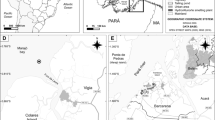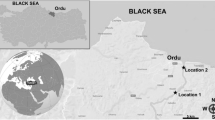Abstract
Different genetic biomarkers have been used to evaluate the pollution effects of mutagenic agents such as metals and also a great variety of chemicals delivered on the environment by human activities. This way, the aim of the present report was to evaluate the effects of inorganic lead in fishes through the frequency of piscine micronuclei and nuclear morphological alterations in peripheral cells, chromosomal aberration frequency and comet assays in blood and kidney cells. Specimens of Hoplias malabaricus received different doses of lead by intra-peritoneal injections at time of 96 h. There was not a significant difference between control and treated groups for the piscine micronucleus and chromosomal aberration assays. In the comet assays there was a significant difference between control and contaminated groups. However, a significant difference between the applied doses was not observed. The results obtained with the comet assays also show that blood presented a higher sensibility than the kidney tissue, possibly due to the acute contamination. Although the results showed the genotoxic potential of lead at the 21 and 63 µg Pb2 + /g doses for both tissues, the lowest dose is considered more appropriate for future bioassays.
Similar content being viewed by others
References
Akaishi, F. M., Silva de Assis, H. C., Jakobi, S. C. G., Eiras-Stofella, D. R., ST-Jean, S. D., Courtenay, S. C., et al. (2004). Morphological and neurotoxicological findings in tropical freshwater fish (Astyanax sp.) after waterborne and acute exposure to water soluble fraction (WSF) of crude oil. Archives of Environmental Contamination and Toxicology, 46, 244–253.
Almeida Toledo, L. F., Viegas-Péquignot, E., Foresti, F., Toledo Filho, S. A., & Dutrilaux, B. (1988). BrdU replication patterns demonstrating chromosome homoeologies in two fish species, genus Eigenmannia. Cytogenetics and Cell Genetics, 48, 117–120. doi:10.1159/000132603.
Al-Sabti, K. (1986). Clastogenic effects of live carcinogenic mutagenic chemicals on the cells of the common carp (Cyprinus carpio L.). Comparative Biochemistry and Physiology, 85(Part C), 5–9.
Belpaeme, K., Cooreman, K., & Kirsch-Volders, M. (1998). Development and validation of the in vivo alkaline comet assay for detecting genomic damage in marine flatfish. Mutation Research, 415(3), 167–184.
Boelsterli, U. A. (2002). Mechanistic toxicology. The molecular basis of how chemicals disrupt biological targets. London: Taylor and Francis.
Bombail, V., Aw, D., Gordon, E., & Batty, J. (2001). Application of the comet and micronucleus assays to butterfish (Pholis gunnellus) erythrocytes from the Firth of Forth, Scotland. Chemosphere, 44, 383–392. doi:10.1016/S0045-6535(00)00300-3.
BRASIL (1986). Resolução do CONAMA No. 20, de 18 de junho de 1986. Diário Oficial da República Federativa do Brasil. Brasília, pp. 72–89.
Burdena, V. M., Sandheinrich, M. B., & Caldwell, C. A. (1998). Effects of lead on the growth and 6-aminolevulinic acid dehydratase activity of juvenile rainbow trout, Oncorhynchus mykiss. Environmental Pollution, 101, 285–289. doi:10.1016/S0269-7491(98)00029-3.
Carrasco, K. R., Tilbury, K. L., & Myers, M. S. (1990). Assessment of the piscine micronucleus test as in situ biological indicator of chemical contaminant effects. Canadian Journal of Fisheries and Aquatic Sciences, 47, 2123–2136. doi:10.1139/f90-237.
Cestari, M. M., Lemos, P. M. M., Oliveira - Ribeiro, C. A., Costa, J. R. M. A., Pelletier, E., Ferraro, M. V. M., et al. (2004). Genetic damage induced by trophic doses of lead in the neotropical fish Hoplias malabaricus (Characiformes, Erythrinidae) as reveled by the comet assay and chromosomal aberrations. Genetics and Molecular Biology, 27(2), 270–274. doi:10.1590/S1415-47572004000200023.
Cipriano, R. R., Oliveira-Ribeiro, C. A., Cestari, M. M., & Fenocchio, A. S. (2004). Evaluation of the effects of tributiltin (TBT) on chromosomes of the neotropical fish Astyanax sp. (Pisces, Tetragonopterinae). Cytologia, 69(2), 187–190. doi:10.1508/cytologia.69.187
Costa, J. R. M., Mela, M., Assis, H. C. S., Pelletier, É., Randi, M. A. F., & Oliveira-Ribeiro, C. A. (2007). Enzymatic inhibition and morphological changes in Hoplias malabaricus from dietary exposure to lead (II) or methylmercury. Ecotoxicology and Environmental Safety, 67, 82–88. doi:10.1016/j.ecoenv.2006.03.013.
Devaux, A., Pesonen, M., & Monod, G. (1997). Alkaline comet assay in rainbow trout hepatocytes. Toxicology In Vitro, 11, 71–79. doi:10.1016/S0887-2333(97)00004-0.
Fenocchio, A. S., & Bertollo, L. A. C. (1988). A simple method for fresh-water fish lymphocyte culture. Brazilian Journal of Genetics, 11(4), 847–852.
Fenocchio, A. S., Venere, P. C., Cesar, A. C. G., Dias, A. L., & Bertollo, L. A. C. (1991). Short term culture from solid tissues of fishes. Caryologia, 44, 161–166.
Ferraro, M. V., Fenocchio, A. S., Mantovani, M. S., Oliveira-Ribeiro, C. A., & Cestari, M. M. (2004). Mutagenic effects of tributyltin (TBT) and inorganic lead (PbII) on the fish H. malabaricus as evaluated using the comet assay, piscine micronucleus and chromosome aberrations tests. Genetics and Molecular Biology, 27(1), 103–107. doi:10.1590/S1415-47572004000100017.
Gurer-Orhan, H., Sabýr, H. U., & Özgünes, H. (2004). Correlation between clinical indicators of lead poisoning and oxidative stress parameters in controls and lead-exposed workers. Toxicology, 195, 147–154. doi:10.1016/j.tox.2003.09.009.
Hartwig, A., Asmuss, M., Blessing, H., Hoffmann, S., Jahnke, G., Khandelwal, S., et al. (2002). Interference by toxic metal ions with zinc-dependent proteins involved in maintaining genomic stability. Food and Chemical Toxicology, 40, 1179–1184. doi:10.1016/S0278-6915(02)00043-1.
Heddle, J. A. (1973). A rapid in vivo test for chromosome damage. Mutation Research, 18, 187–192. doi:10.1016/0027-5107(73)90035-3.
Hooftman, R. N., & de Raat, W. K. (1982). Induction of nuclear anomalies (micronuclei) in the peripheral blood erythrocytes of the eastern mudminnow Umbra pygmea by ethyl methanesulphonate. Mutation Research, 104, 147–152. doi:10.1016/0165-7992(82)90136-1.
Hose, J. E., Cross, J. N., Smith, S. G., & Diehl, D. (1987). Elevated circulating erythrocyte micronuclei in fishes from contaminated of southern California. Marine Environmental Research, 22, 167–176. doi:10.1016/0141-1136(87)90034-1.
Johnson, F. M. (1998). The genetic effects of environmental lead. Mutation Research/Reviews in Mutation Research, 410, 123–140. doi:10.1016/S1383-5742(97)00032-X.
Kassie, F., Parzefall, W., & Knasmüller, S. (2000) Single cell gel electrophoresis assay: A new technique for human biomonitoring studies. Mutation Research, 463, 13–31.
Kim, I. Y., & Hyun, C. K. (2006). Comparative evaluation of the alkaline comet assay with the micronucleus test for genotoxicity monitoring using aquatic organisms. Ecotoxicology and Environmental Safety, 64, 288–297. doi:10.1016/j.ecoenv.2005.05.019.
Kobayashi, H., Sugiyama, C., Morikawa, Y., Hayashi, M., & Sofuni, T. (1995) A comparison between manual microscopic analysis and computerized image analysis in the single cell gel electrophoresis. Mammalian Mutagenicity Study Group Communications, 3, 103–115.
McCarthy, J. F., & Shugart, L. R. (1990). Biomarkers of environmental contamination. Boca Raton: Lewis.
Merian, E. (Ed.) (1991). Metals and their compounds in the environment: Occurrence, analysis and biological relevance. New York: VCH.
Metcalfe, C. D. (1989). Testes for predicting carcinogenicity in fish. CRC Critical Reviews in Aquatic Sciences, 1, 111–129.
Mitchelmore, C. L., Chipman, J. K. (1998). DNA strand breakage in aquatic organisms and the potential value of the comet assay in environmental monitoring. Mutation Research—Fundamental and Molecular Mechanisms of Mutagenesis, 399, 135–147.
Obe, G., Pfeiffer, P., Savage, J. R. K., Johannes, C., Goedecke, W., Jeppesen, P., et al. (2002). Chromosomal aberrations: formation, identification and distribution. Mutation Research—Fundamental and Molecular Mechanisms of Mutagenesis, 504, 17–36.
Ogunseitan, O. A., Yang, S., & Ericson, J. (2000). Microbial δ-aminolevulinate dehydratase as a biosensor of lead bioavailability in contaminated environments. Soil Biology & Biochemistry, 32, 1899–1906. doi:10.1016/S0038-0717(00)00164-4.
Pain, D. J. (1995). Lead in the environment. In D. J. Hoffman, B. A. Rattner, G. A. Burton & J. Cairns (Eds.), Handbook of ecotoxicology (pp. 356–391). Boca Raton: Lewis.
Pandrangi, R., Petras, M., Ralph, S., & Vrzoc, M. (1995). Alkaline single cell gel (comet): Assay and genotoxicity monitoring using bullheads and carp. Environmental and Molecular Mutagenesis, 26, 345–356. doi:10.1002/em.2850260411.
Rabitto, I. S., Alves Costa, J. R. M., Silva de Assis, H. C., Pelletier, E., Akaishi, F. M., Anjos, A., et al. (2005). Effects of dietary Pb(II) and tributyltin on neotropical fish, Hoplias malabaricus: histopathological and biochemical findings. Ecotoxicology and Environmental Safety, 60(2), 147–156. doi:10.1016/j.ecoenv.2004.03.002.
Rios, F. S., Oba, E. T., Fernandes, M. N., Kalinin, A. L., & Rantin, F. T. (2005). Erythrocyte senescence and haematological changes induced by starvation in the neotropical fish traíra, Hoplias malabaricus (Characiformes, Erythrinidae). Comparative Biochemistry and Physiology Part A, 140, 281–287. doi:10.1016/j.cbpb.2004.12.006.
Schmid, W. (1975). The micronucleus test. Mutation Research, 31, 9–15.
Soldatov, A. A. (2005). Peculiarities of organization and functioning of the fish red blood system. Journal of Evolutionary Biochemistry and Physiology, 41(3), 272–281. doi:10.1007/s10893-005-0060-0.
Speit, G., & Hartmann, A. (1999) The comet assay (single-cell gel test), a sensitive test for the detection of DNA damage and repair. In D. S. Henderson (Ed.), Methods in molecular biology: DNA repair protocols—eukaryotic systems (pp. 203–211). Totowa: Human.
Tao, S., Liu, C., Dawson, R., Cao, J., & Li, B. (1999). Uptake of particulate lead via the gills of fish (Carassius auratus). Archives of Environmental Contamination and Toxicology, 37, 352–357. doi:10.1007/s002449900524.
Udroiu, I. (2006). The micronucleus test in piscine erythrocytes. Aquatic Toxicology (Amsterdam, Netherlands), 79, 201–204. doi:10.1016/j.aquatox.2006.06.013.
Van Der Oost, R., Beyer, J., & Vermeulen, N. P. E. (2003). Fish bioaccumulation and biomarkers in environmental risk assessment: a review. Environmental Toxicology and Pharmacology, 13, 57–149. doi:10.1016/S1382-6689(02)00126-6.
Vighi, M. (1981). Lead uptake and release in a experimental trophic chain. Ecotoxicology and Environmental Safety, 5, 177–193. doi:10.1016/0147-6513(81)90033-6.
Author information
Authors and Affiliations
Corresponding author
Rights and permissions
About this article
Cite this article
Ramsdorf, W.A., Ferraro, M.V.M., Oliveira-Ribeiro, C.A. et al. Genotoxic evaluation of different doses of inorganic lead (PbII) in Hoplias malabaricus . Environ Monit Assess 158, 77–85 (2009). https://doi.org/10.1007/s10661-008-0566-1
Received:
Accepted:
Published:
Issue Date:
DOI: https://doi.org/10.1007/s10661-008-0566-1




